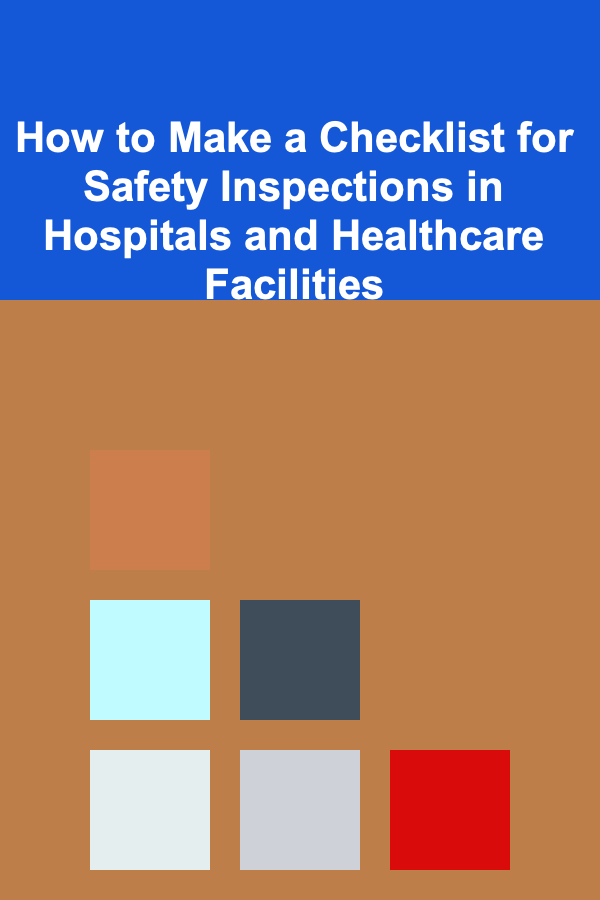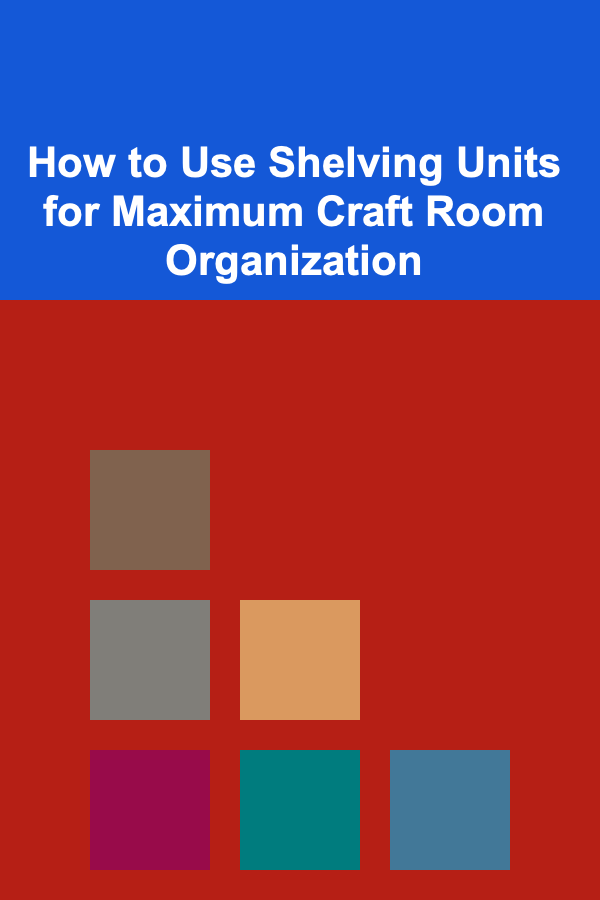
How to Make a Checklist for Safety Inspections in Hospitals and Healthcare Facilities
ebook include PDF & Audio bundle (Micro Guide)
$12.99$11.99
Limited Time Offer! Order within the next:

Safety inspections in hospitals and healthcare facilities are critical to ensuring the well-being of patients, staff, and visitors. A well-constructed safety checklist is essential for identifying potential hazards, ensuring compliance with regulations, and maintaining a safe environment. By creating a thorough, actionable checklist, healthcare facilities can prevent accidents, improve operational efficiency, and meet legal requirements.
This guide will walk you through the process of creating a comprehensive safety inspection checklist tailored for hospitals and healthcare facilities. It will cover key areas to include, the best practices for inspection, and how to ensure that safety protocols are consistently followed.
Step 1: Understand the Legal and Regulatory Requirements
Before creating your safety inspection checklist, it is crucial to understand the relevant laws and regulations that govern safety in healthcare settings. Compliance with these standards is not only a legal requirement but also a best practice for protecting everyone in the facility.
Key Regulations to Consider:
- Occupational Safety and Health Administration (OSHA): OSHA sets standards for workplace safety in healthcare facilities, including hazard communication, personal protective equipment (PPE), and bloodborne pathogen exposure.
- The Joint Commission: This non-profit organization accredits healthcare organizations and ensures that they meet certain safety and quality standards. Their requirements cover areas like infection control, emergency preparedness, and environmental safety.
- Centers for Disease Control and Prevention (CDC): The CDC offers guidelines on infection control, especially concerning the handling of hazardous materials and infectious diseases.
- National Fire Protection Association (NFPA): The NFPA offers regulations on fire safety, including fire alarms, sprinklers, and evacuation routes.
Familiarize yourself with these regulations and incorporate relevant standards into your checklist. This will help ensure that the checklist covers all required aspects of safety and complies with local and national regulations.
Step 2: Identify Key Areas for Safety Inspections
Safety inspections in hospitals and healthcare facilities span a variety of areas. Your checklist should address the following key aspects:
1. Facility Condition and Environmental Safety
- Physical Infrastructure: Inspect walls, ceilings, floors, and windows for damage or hazards (e.g., cracks, exposed wires, or moisture).
- Lighting: Ensure proper lighting in hallways, staircases, parking lots, and patient rooms to reduce the risk of accidents.
- Emergency Exits: Verify that all emergency exits are clearly marked, easily accessible, and free of obstructions.
- Waste Disposal: Check that hazardous waste containers are properly labeled, sealed, and disposed of according to safety protocols.
- Pest Control: Inspect for any signs of pests and ensure pest control measures are in place.
2. Fire Safety
- Fire Extinguishers: Ensure fire extinguishers are accessible, fully charged, and regularly serviced.
- Fire Alarms: Test fire alarms to ensure they are functioning properly.
- Evacuation Routes: Verify that evacuation routes are clearly marked and unobstructed.
- Sprinkler Systems: Inspect sprinkler systems to ensure they are operational and free from blockages.
3. Electrical and Mechanical Systems
- Electrical Panels: Inspect electrical panels for signs of overheating, exposed wiring, or malfunctioning circuit breakers.
- Medical Equipment: Ensure that medical equipment is maintained according to manufacturer instructions and is safe for use.
- HVAC Systems: Inspect heating, ventilation, and air conditioning systems for cleanliness, proper function, and filter replacement.
4. Infection Control and Hygiene
- Sanitization Stations: Verify that hand sanitizers are stocked and placed at strategic points, especially near patient beds and high-traffic areas.
- Personal Protective Equipment (PPE): Ensure that PPE, such as masks, gloves, gowns, and face shields, are readily available and in good condition.
- Disinfection Protocols: Check that high-touch surfaces are disinfected regularly and that disinfection logs are up to date.
- Waste Management: Ensure that biohazardous waste is separated, handled safely, and disposed of properly.
5. Patient Safety and Emergency Preparedness
- Patient Identification: Ensure proper patient identification protocols are in place to prevent medical errors.
- Fall Prevention: Verify that beds, chairs, and walkways are free of obstacles, and that appropriate fall prevention measures are in place (e.g., handrails, non-slip mats).
- Emergency Drills: Confirm that emergency drills (e.g., fire, earthquake, or active shooter) are conducted regularly and that staff are trained on proper emergency procedures.
6. Workplace Safety
- Slip and Fall Hazards: Check for wet floors, uneven surfaces, or any other hazards that could lead to slips or falls.
- Lift and Transfer Protocols: Ensure that proper lifting and transfer equipment is available for patients, and that staff are trained on safe patient handling techniques.
- Staff Training: Verify that staff members are regularly trained on safety protocols, including fire safety, first aid, and handling hazardous materials.
Step 3: Create the Safety Inspection Checklist
With the key areas identified, you can now create your safety inspection checklist. Ensure that it is detailed, easy to follow, and covers all aspects of safety within the facility.
Here is an example of what a safety inspection checklist might look like:
Example: Hospital Safety Inspection Checklist
Facility Condition
- [ ] Check walls, ceilings, and floors for damage
- [ ] Ensure all emergency exits are clearly marked and accessible
- [ ] Verify that lighting is adequate in all areas
- [ ] Check waste disposal bins for proper labeling and sealing
- [ ] Inspect pest control measures
Fire Safety
- [ ] Test fire alarms and ensure they are working properly
- [ ] Ensure fire extinguishers are easily accessible and serviced
- [ ] Verify that fire evacuation routes are clear and marked
- [ ] Inspect sprinkler systems for functionality
Infection Control
- [ ] Ensure sanitization stations are stocked and accessible
- [ ] Verify that PPE is available and in good condition
- [ ] Ensure proper disinfection protocols are followed
- [ ] Check that biohazardous waste is correctly separated and disposed of
Emergency Preparedness
- [ ] Verify that emergency drills are conducted regularly
- [ ] Ensure fall prevention measures are in place
- [ ] Check that patient identification procedures are followed
Workplace Safety
- [ ] Inspect for slip and fall hazards
- [ ] Ensure proper lifting equipment and training for patient transfers
- [ ] Verify that staff have received up-to-date safety training
Step 4: Conduct Regular Inspections
Once your checklist is created, it is essential to schedule regular safety inspections to ensure ongoing compliance and maintenance of safety standards. The frequency of inspections will depend on the size and complexity of the healthcare facility. For instance, high-risk areas like patient rooms, operating theaters, and emergency departments should be inspected more frequently than non-critical areas.
Best Practices for Conducting Inspections:
- Delegate Responsibilities: Assign specific staff members to conduct inspections and keep track of the results.
- Use Digital Tools: Utilize mobile apps or software designed for safety inspections to streamline the process and improve documentation.
- Document Findings: Record all findings, corrective actions taken, and any follow-up steps required. This documentation is crucial for tracking improvements and demonstrating compliance during audits.
- Involve Staff: Involve healthcare staff in the inspection process to gather feedback and make them feel more accountable for maintaining a safe environment.
Step 5: Address Identified Hazards and Implement Corrective Actions
After each inspection, it is essential to address any identified safety hazards and implement corrective actions as needed. This might include repairing damaged infrastructure, updating safety protocols, or providing additional training for staff.
Key Steps in Addressing Hazards:
- Prioritize Risks: Identify which hazards pose the most immediate risk to health and safety and prioritize corrective actions.
- Take Immediate Action: For high-risk issues (e.g., electrical hazards or fire safety concerns), take immediate corrective action to resolve the problem.
- Follow Up: Schedule follow-up inspections to ensure that corrective actions have been effective and that new issues have not arisen.
Conclusion
Creating a safety inspection checklist for hospitals and healthcare facilities is essential for ensuring a safe and secure environment for everyone. By following the steps outlined in this guide, healthcare organizations can develop a comprehensive and actionable checklist that covers all aspects of safety. Regular inspections, proper documentation, and timely corrective actions are key to maintaining a safe facility that complies with legal requirements and provides optimal care to patients and staff.
By taking safety seriously and making safety inspections a regular part of your healthcare facility's routine, you can foster a culture of safety, prevent accidents, and improve overall healthcare outcomes.
Reading More From Our Other Websites
- [Home Staging 101] How to Stage Your Home's Basement to Appeal to Buyers
- [Personal Care Tips 101] How to Use a Razor with Shaving Cream for the Smoothest Results
- [Home Holiday Decoration 101] How to Use Scented Candles to Enhance Your Holiday Ambiance
- [Organization Tip 101] How to Use Tags and Labels for Better File Retrieval
- [Home Storage Solution 101] How to Maximize Bathroom Storage Without Compromising Style
- [Organization Tip 101] How to Use Affirmations in Your Decor for Positive Energy
- [Biking 101] 10 Essential Cycling Tips for Beginners
- [Home Lighting 101] How to Update Your Lighting Fixtures for a Fresh Look
- [Small Business 101] Small Business Insurance Quotes: Understanding What's Included in Your Policy
- [Gardening 101] Essential Tips for Maintaining and Repairing Your Garden Fence

How to Create a Family Craft Night Tradition
Read More
How to Create a Party Playlist that Will Keep Your Guests Dancing All Night
Read More
How to Make Your Bathroom Festive for the Holidays
Read More
How to Use Shelving Units for Maximum Craft Room Organization
Read More
How to Get Started with Freelance Income
Read More
How to Manage Content Marketing Budgets Effectively
Read MoreOther Products

How to Create a Family Craft Night Tradition
Read More
How to Create a Party Playlist that Will Keep Your Guests Dancing All Night
Read More
How to Make Your Bathroom Festive for the Holidays
Read More
How to Use Shelving Units for Maximum Craft Room Organization
Read More
How to Get Started with Freelance Income
Read More